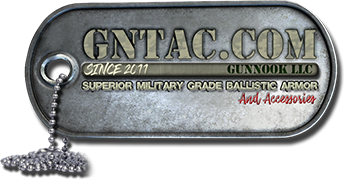Cart

Our primary goal is our 100% customer satisfaction guarantee. We pride ourselves on doing everything we can to make sure your order is exactly what you envisioned and we're not happy until you're happy!
Why is The NIJ Standard So Important?
Body armor manufacturers voluntarily provide their own lab testing and evaluation results to show that their products meet NIJ standards. This is vital because body armor must be able to reliably provide the required level of protection. NIJ standards safeguard buyers by ensuring that the protection level of the armor they buy meets their needs. Manufacturers who maintain NIJ Certification can meet the qualifications necessary for grant funding, which is very important.
Publication of the final version of NIJ Standard 0101.07 is anticipated to occur in the beginning of 2021. The upcoming NIJ Standard 0101.07 improves the test methods along with the performance requirements for the level of ballistic resistance that body armor meant to protect the torso from handgun and rifle fire must have. The NIJ Standard 0101.07 is a bit more stringent when compared to the NIJ Standard 0101.06. Conditioned armor panels are required to be shot at the very same velocity that is required of non-conditioned armor.
The descriptions used in explaining threat levels have been rewritten to more precisely describe types of threats in attempt to avoid confusion among those in law enforcement who use body armor.
Body armor covered by the 0101.07 Standard is categorized into five separate levels of protection.
The new terms of HG1 and HG2 more clearly represent HandGun (HG) threats than the previously used terms of Level II and Level IIIA, which they replace.
The new terms of RF1 and RF3 more clearly represent RiFle (RF) threats than the previously used terms of Level III and Level IV, which they replace. RF2 is a completely new threat level representing an intermediate threat, which will be in the NIJ Standard 0101.07.
Standard 0101.07 – HandGun Threat Levels
The Level IIA threat level against low velocity handgun rounds, such as the 9mm FMJ RN and the .40 S&W FMJ, no longer appears in the new NIJ Standard 0101.07.The Level II threat level is renamed NIJ HG1. Test rounds used are the same as in the previous NIJ 0101.06 Standard, namely 9mm FMJ RN and .357 Mag. JSP.
The Level IIIA threat is renamed NIJ HG2. The armor panels for this threat level will no longer be tested with .357 SIG FMJ Flat Nose rounds, but instead with faster 9mm FMJ Round Nose rounds.
The new NIJ Standard 0101.07 requires that the velocity for both new and conditioned body armor be the same. This will pressure manufacturers to ensure their body armor performs at a high level in bleak environments.
NIJ Standard 0101.07 RiFle Threat Levels
There are a lot of differences between the rifle protection levels in the new NIJ Standard 0101.07 and those in the NIJ Standard 0101.06. New test rounds have been introduced along with a completely new threat level.
The rifle threat levels in the NIJ Standard 0101.06 were called Level III and Level IV. These levels have been renamed RF1 and RF3 in the new NIJ Standard 0101.07.
To fill the threat level gap that exists between the new RF1 and RF3, a new RF2 threat level is being introduced. This level protects against 5.56mm M855 rounds shot from 3115 ft./s (950 m/s). This bullet weighs 62 gr. and has a steel core “penetrator” tip, which allows it to pierce through barriers more easily.
In the last few years, body armor manufacturers have been using the names Level III+ or Level III++ to indicate that a plate could stop these stronger rifle rounds.
Soft Armor Panels Designed for Women
The demand for female body armor has increased during the last decade. Therefore NIJ has introduced a special test protocol just for female body armor. Additional test shots are required around the bust cups to ensure that body armor designed for female users offers the same level of ballistic protection in that area as armor designed for men.
NIJ HANDGUN (HG) THREAT LEVELS AND ASSOCIATED TEST AMMUNITION
| NIJ HG Threat Level | Test Threat Ammunition | Manufacturer & Model ID | Reference Velocity |
|---|---|---|---|
| NIJ HG1 (Formerly NIJ 0101.06 Level II) | 9mm Luger full metal jacketed (FMJ) round nose (RN) 124 grain | Remington #23558 | 1305 ft/s (398 m/s) |
| .357 Mag jacketed soft point (JSP) 158 grain | Remington #22847 | 1430 ft/s (436 m/s) | |
| NIJ HG2 (Formerly NIJ 0101.06 Level IIIA) | 9mm Luger FMJ RN 124 grain | Remington #23558 | 1470 ft/s (448 m/s) |
| .44 MAG jacketed hollow point (JHP) 240 grain | Speer #4453 or #4736 | 1430 ft/s (436 m/s) |
NIJ RIFLE (RF) THREAT LEVELS AND ASSOCIATED TEST AMMUNITION
| NIJ RF Threat Level | Test Threat Ammunition | Manufacturer & Model ID | Reference Velocity |
|---|---|---|---|
| NIJ RF1 (Enhanced version of NIJ 0101.06 Level III) | 7.62x51mm M80 Ball NATO FMJ steel jacketed spire point boat tail (BT) 149 +0/-3 grain | U.S. military supply or rounds meeting NATO specifications | 2780 ft/s (847 m/s) |
| 7.62x39mm surrogate test round 120.5 grain (7.81 g) | Specifications provided by NIJ (See Ref. 16) | 2380 ft/s (725 m/s) | |
| 5.56mm M193 BT 56 +0/-2 grain | U.S. military supply or rounds meeting NATO specifications | 3250 ft/s (990 m/s) | |
| NIJ RF2 (Same as NIJ RF1 plus 5.56 mm M855) | 7.62x51mm M80 Ball NATO FMJ steel jacketed spire point BT 149 +0/-3 grain | US military supply or rounds meeting NATO specifications | 2780 ft/s (847 m/s) |
| 7.62x39mm surrogate test round 120.5 grain (7.81 g) | Specifications provided by NIJ (See Ref. 16) | 2380 ft/s (725 m/s) | |
| 5.56mm M193 BT 56 +0/-2 grain | U.S. military supply or rounds meeting NATO specifications | 3250 ft/s (990 m/s) | |
| 5.56mm M855 BT 61.8 ± 1.5 grain | U.S. military supply or rounds meeting NATO specifications | 3115 ft/s (950 m/s) | |
| NIJ RF3 (Formerly NIJ 0101.06 Level IV) | 30.06 M2 Armor Piercing (AP) FMJ spire point AP 165.7 +0/-7 grain | U.S. military supply or rounds meeting NATO specifications | 2880 ft/s (878 m/s) |
V50 Fragmentation Performance
The V50 test is the internationally recognized standard for assessing the fragmentation resistance of personal protection. The fragmentation test is conducted using Fragment Simulating Projectiles (FSPs) which are available in a range of weights approximately following the binomial progression. The test is conducted by firing FSPs at the armor at increasing velocities until an average velocity of penetrating and non-penetrating projectiles is obtained.
The higher the ballistic speed, measured in meters per second, the higher the rating of material, shown as V50 000m/s. The V50 (Velocity 50% or mean velocity) is the average of the velocities recorded for six fair impacts consisting of the three lowest velocities for complete penetration and the three highest velocities for partial penetration.
TLDR; “V-50″ or” Velocity-50%” – is a ballistic test where artificial fragments are fired at higher and higher velocities until they start penetrating. The velocity of the fragments where 50% of the bullets DON’T penetrate, and 50% of the bullets DO penetrate is the V-50 rating for that ballistic protection.
